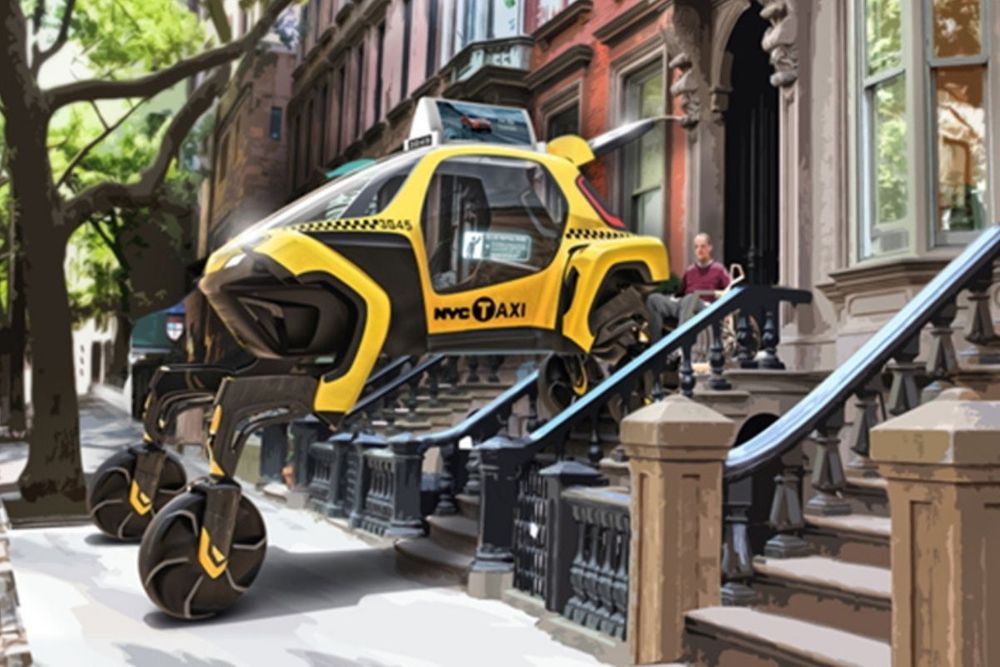The Hyundai Elevate ultimate mobility vehicle (UMV) concept’s sure-footed ability to navigate irregular ground provides the versatility required during rescue situations, such as after an earthquake.
The 150-year-old automotive industry is navigating a period of transformational change and needs to innovate: strict climate regulations, electric vehicle (EV) start-ups disrupting established markets, changing personal travel habits, shipping patterns and global supply chains are just a few of the forces dictating that established auto manufacturers absolutely must innovate now. Cars of tomorrow and today need to become more versatile and adaptable, smarter and safer, more fuel efficient and otherwise sustainable than the cars of just a few years ago.
A unique mobility solution–something that drives and walks–presents immensely difficult design and engineering challenges. One of the most common amongst these is a never-ending quest in the transportation industry: create components that are lighter, but stronger, than past generations of similar components. Designers and engineers tasked with these “lightweighting” challenges frequently look to futuristic materials such as metallic foams, carbon fiber and new metal alloys, along with modern design techniques such as generative design, for solutions. These are areas where Autodesk’s tools and expertise excel, so Hyundai turned to Autodesk for input.
Operating at one of the epicenters of global innovation–the region that Apple, Google, Tesla, Twitter and Stanford call home–Suh is well positioned to spearhead one of Hyundai Motor Group’s more futuristic approaches to addressing these challenges. Hyundai’s New Horizons Studio believes that the combination of driven wheels and powered legs will result in ground vehicles with unprecedented locomotion capabilities. The studio aims to contribute to Hyundai Motor Group’s core automotive business as it seeks to expand into new markets that enhance transportation on and off the road. Accordingly, being guided by an executive with a robust imagination, informed by the megahit robots-that-become-cars toys of the ‘80s, is probably a strategic advantage.
“What could a car achieve if it had the ability to walk?” continued Suh’s thinking, which ultimately resulted in the walking “Elevate” concept that Hyundai developed in collaboration with storied industrial design studio Sundberg-Ferar and debuted at CES 2019. Called the ultimate mobility vehicle (or “UMV”), Elevate has the ability to transform from a four-wheeled, car-like vehicle into a four-legged, reptilian walking machine, giving it the ability to traverse terrain that’s inaccessible to even the most capable off-road vehicles. When originally debuted, it was heralded for its ability to climb walls, cross diverse terrains and approach barriers, all while keeping its body and passengers completely level.
Uses for such a vehicle include irregular-ground transport needs, surface exploration, search and rescue emergencies, and clearing the significant transportation hurdles some mobility-impaired individuals face daily.

Use cases for the Hyundai Elevate UMV concept include helping people with mobility challenges navigate cities.
Generative design to streamline and accelerate the process of developing design ideas and getting to production. In the time a designer can create one idea, a computer can generate thousands, within the constraints provided by the designer, and present those numerous design options with the trade-offs of strength, weight, cost, manufacturing complexity and sustainability clearly illustrated early in the process. Autodesk’s tools provide options through which designers and engineers may tap the near-limitless compute power of the cloud to reduce their mundane, repetitive analysis work, freeing up their time to focus on creativity and innovation.
Generative design streamlines and accelerates the process of developing design ideas and getting to production. In the time a designer can create one idea, a computer can generate thousands, within the constraints provided by the designer, and present those numerous component design options with the trade-offs of strength, weight, cost, manufacturing complexity and sustainability clearly illustrated early in the process. Autodesk’s tools enable designers and engineers to tap the near-limitless compute power of the cloud to reduce their mundane, repetitive analysis work, freeing up their time to focus on creativity and innovation.

John Suh, Hyundai’s founding director of the company’s New Horizons Studio, examines components of the versatile Elevate prototype that need to be exceedingly strong and light. Suh says:
“Generative design helps the human mind expand the range of possibilities. With the help of generative design, a single designer or engineer can go through perhaps dozens or hundreds of different design iterations, so it enables them to see things that they may not have otherwise considered, and in tandem tackle complex problems. Which is to say that people still have a very important role to play in shaping the design direction. There will always be need for the human eye, the heart, and the soul as vital parts of the design process.”
In the case of the Elevate concept vehicle, high-torque electric motors are at each joint of the “legs.” This requires structural components be strong and rigid. But vehicle handling and payload requirements demand they, and the in-motor driven wheels, which are the “feet” of the vehicle, be lightweight. To achieve these and other goals, particularly with the international presence of Hyundai, a design and engineering toolset that makes it easy to share across teams, companies and continents is mandatory.

An exploded view illustration of the Elevate vehicle shows components that enable it to transform from a rolling vehicle to one that walks.
Creating tools for modern teams of this nature, leveraging the cloud and a common data platform to ensure everyone’s on the same virtual page: this has been the focus of Autodesk’s Fusion 360 platform since its inception more than seven years ago. Teams can explore how to save time, remove frustration and maintain details of a project from start to finish when file sharing is seamless and everyone’s speaking a common design, engineering and manufacturing language.
Srinath Jonnalagadda, vice president of design and manufacturing at Autodesk says:
“More than 10 years ago, we identified the pain points, rework required and loss of valuable information when projects move from one phase to the next and the associated files don’t play nicely in the heterogenous environments organizations so often use.
Creating a design and engineering platform that helps remove those hurdles, while also putting advanced capabilities such as generative design tools at the fingertips of designers, has been our North Star for a decade. The Elevate project is a showcase of how leaders like Hyundai can now enjoy the fruits of that vision.”
Elevate exists only as a 5:1 scale prototype at this point, so it remains to be seen what’ll come of this fascinating and futuristic Hyundai project. Nevertheless, wrapped in its Transformer-inspired trappings are examples of the potential benefits offered today by a platform that breaks down barriers between design, engineering and manufacturing; makes broad collaboration seamless by standardizing data; and gives teams access to a state-of-the-art, cloud-powered new process like generative design.
Canonical Link: https://www.bizbahrain.com/hyundai-and-autodesk-join-forces-to-design-futuristic-walking-car/
© Copyright 2020 bizbahrain









